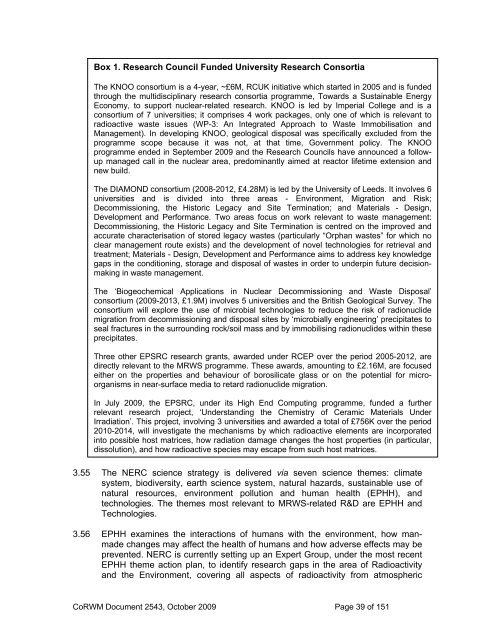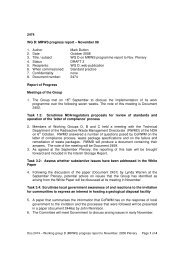2009 Report to Government on National Research and
2009 Report to Government on National Research and
2009 Report to Government on National Research and
- TAGS
- corwm.decc.gov.uk
You also want an ePaper? Increase the reach of your titles
YUMPU automatically turns print PDFs into web optimized ePapers that Google loves.
Box 1. <strong>Research</strong> Council Funded University <strong>Research</strong> C<strong>on</strong>sortia<br />
The KNOO c<strong>on</strong>sortium is a 4-year, ~£6M, RCUK initiative which started in 2005 <strong>and</strong> is funded<br />
through the multidisciplinary research c<strong>on</strong>sortia programme, Towards a Sustainable Energy<br />
Ec<strong>on</strong>omy, <str<strong>on</strong>g>to</str<strong>on</strong>g> support nuclear-related research. KNOO is led by Imperial College <strong>and</strong> is a<br />
c<strong>on</strong>sortium of 7 universities; it comprises 4 work packages, <strong>on</strong>ly <strong>on</strong>e of which is relevant <str<strong>on</strong>g>to</str<strong>on</strong>g><br />
radioactive waste issues (WP-3: An Integrated Approach <str<strong>on</strong>g>to</str<strong>on</strong>g> Waste Immobilisati<strong>on</strong> <strong>and</strong><br />
Management). In developing KNOO, geological disposal was specifically excluded from the<br />
programme scope because it was not, at that time, <str<strong>on</strong>g>Government</str<strong>on</strong>g> policy. The KNOO<br />
programme ended in September <str<strong>on</strong>g>2009</str<strong>on</strong>g> <strong>and</strong> the <strong>Research</strong> Councils have announced a followup<br />
managed call in the nuclear area, predominantly aimed at reac<str<strong>on</strong>g>to</str<strong>on</strong>g>r lifetime extensi<strong>on</strong> <strong>and</strong><br />
new build.<br />
The DIAMOND c<strong>on</strong>sortium (2008-2012, £4.28M) is led by the University of Leeds. It involves 6<br />
universities <strong>and</strong> is divided in<str<strong>on</strong>g>to</str<strong>on</strong>g> three areas - Envir<strong>on</strong>ment, Migrati<strong>on</strong> <strong>and</strong> Risk;<br />
Decommissi<strong>on</strong>ing, the His<str<strong>on</strong>g>to</str<strong>on</strong>g>ric Legacy <strong>and</strong> Site Terminati<strong>on</strong>; <strong>and</strong> Materials - Design,<br />
Development <strong>and</strong> Performance. Two areas focus <strong>on</strong> work relevant <str<strong>on</strong>g>to</str<strong>on</strong>g> waste management:<br />
Decommissi<strong>on</strong>ing, the His<str<strong>on</strong>g>to</str<strong>on</strong>g>ric Legacy <strong>and</strong> Site Terminati<strong>on</strong> is centred <strong>on</strong> the improved <strong>and</strong><br />
accurate characterisati<strong>on</strong> of s<str<strong>on</strong>g>to</str<strong>on</strong>g>red legacy wastes (particularly “Orphan wastes” for which no<br />
clear management route exists) <strong>and</strong> the development of novel technologies for retrieval <strong>and</strong><br />
treatment; Materials - Design, Development <strong>and</strong> Performance aims <str<strong>on</strong>g>to</str<strong>on</strong>g> address key knowledge<br />
gaps in the c<strong>on</strong>diti<strong>on</strong>ing, s<str<strong>on</strong>g>to</str<strong>on</strong>g>rage <strong>and</strong> disposal of wastes in order <str<strong>on</strong>g>to</str<strong>on</strong>g> underpin future decisi<strong>on</strong>-<br />
making in waste management.<br />
The ‘Biogeochemical Applicati<strong>on</strong>s in Nuclear Decommissi<strong>on</strong>ing <strong>and</strong> Waste Disposal’<br />
c<strong>on</strong>sortium (<str<strong>on</strong>g>2009</str<strong>on</strong>g>-2013, £1.9M) involves 5 universities <strong>and</strong> the British Geological Survey. The<br />
c<strong>on</strong>sortium will explore the use of microbial technologies <str<strong>on</strong>g>to</str<strong>on</strong>g> reduce the risk of radi<strong>on</strong>uclide<br />
migrati<strong>on</strong> from decommissi<strong>on</strong>ing <strong>and</strong> disposal sites by ‘microbially engineering’ precipitates <str<strong>on</strong>g>to</str<strong>on</strong>g><br />
seal fractures in the surrounding rock/soil mass <strong>and</strong> by immobilising radi<strong>on</strong>uclides within these<br />
precipitates.<br />
Three other EPSRC research grants, awarded under RCEP over the period 2005-2012, are<br />
directly relevant <str<strong>on</strong>g>to</str<strong>on</strong>g> the MRWS programme. These awards, amounting <str<strong>on</strong>g>to</str<strong>on</strong>g> £2.16M, are focused<br />
either <strong>on</strong> the properties <strong>and</strong> behaviour of borosilicate glass or <strong>on</strong> the potential for microorganisms<br />
in near-surface media <str<strong>on</strong>g>to</str<strong>on</strong>g> retard radi<strong>on</strong>uclide migrati<strong>on</strong>.<br />
In July <str<strong>on</strong>g>2009</str<strong>on</strong>g>, the EPSRC, under its High End Computing programme, funded a further<br />
relevant research project, ‘Underst<strong>and</strong>ing the Chemistry of Ceramic Materials Under<br />
Irradiati<strong>on</strong>’. This project, involving 3 universities <strong>and</strong> awarded a <str<strong>on</strong>g>to</str<strong>on</strong>g>tal of £756K over the period<br />
2010-2014, will investigate the mechanisms by which radioactive elements are incorporated<br />
in<str<strong>on</strong>g>to</str<strong>on</strong>g> possible host matrices, how radiati<strong>on</strong> damage changes the host properties (in particular,<br />
dissoluti<strong>on</strong>), <strong>and</strong> how radioactive species may escape from such host matrices.<br />
3.55 The NERC science strategy is delivered via seven science themes: climate<br />
system, biodiversity, earth science system, natural hazards, sustainable use of<br />
natural resources, envir<strong>on</strong>ment polluti<strong>on</strong> <strong>and</strong> human health (EPHH), <strong>and</strong><br />
technologies. The themes most relevant <str<strong>on</strong>g>to</str<strong>on</strong>g> MRWS-related R&D are EPHH <strong>and</strong><br />
Technologies.<br />
3.56 EPHH examines the interacti<strong>on</strong>s of humans with the envir<strong>on</strong>ment, how manmade<br />
changes may affect the health of humans <strong>and</strong> how adverse effects may be<br />
prevented. NERC is currently setting up an Expert Group, under the most recent<br />
EPHH theme acti<strong>on</strong> plan, <str<strong>on</strong>g>to</str<strong>on</strong>g> identify research gaps in the area of Radioactivity<br />
<strong>and</strong> the Envir<strong>on</strong>ment, covering all aspects of radioactivity from atmospheric<br />
CoRWM Document 2543, Oc<str<strong>on</strong>g>to</str<strong>on</strong>g>ber <str<strong>on</strong>g>2009</str<strong>on</strong>g> Page 39 of 151



